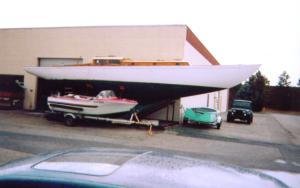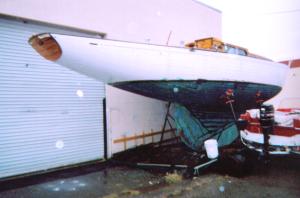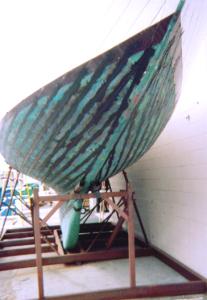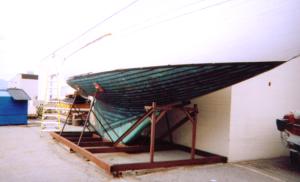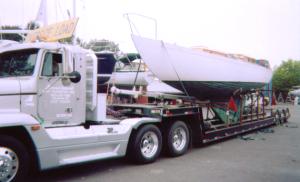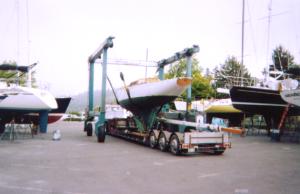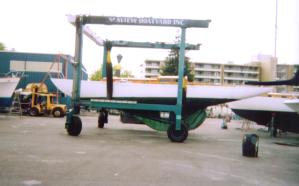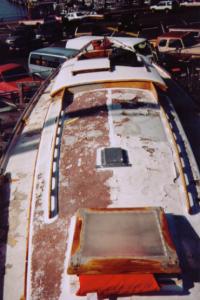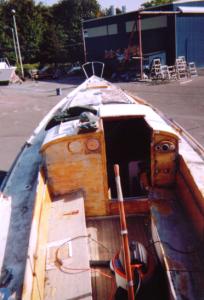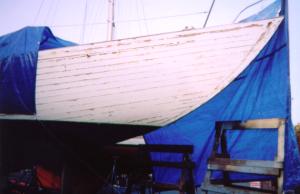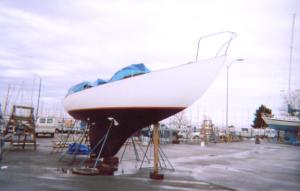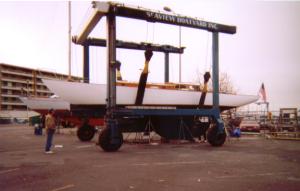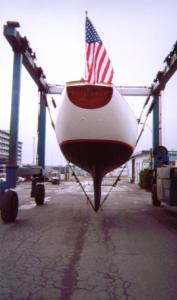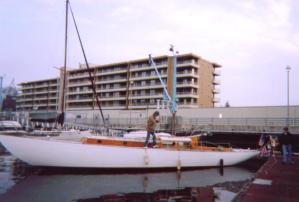by Neil Atwood
Posted: January 31, 2005
|
Seattle, Washington: John Vallone, the previous owner of EULALIE had her
transported from Ventura, California to Salt Lake City, Utah on September
24, 2002. That is where EULALIE sat on a metal cradle uncovered, outside the
previous owner's rented warehouse, in the parking lot of an industrial park.
Salt Lake City is high desert at 2,000 feet above sea level.
Steve Barber, the owner of the Kettenburg Boat Works Owners Association web site became aware of the sale of EULALIE, and the related circumstances in June, 2004. The previous owner had died suddenly in March 2004. The owner of the industrial park had another person renting EULALIE's previous owner's warehouse, effective as of October 1, 2004. Consequently, EULALIE had to be moved by the end of September, or she would be cut up, and hauled away. Steve began posting distress signals in June 2004 on the web site's bulletin board. A couple of other people expressed an interest in buying EULALIE. However, I was the only person to step forward. I bought EULALIE after six weeks of negotiations with all of the people involved, with Steve's help. EULALIE had lost her structural integrity because all of the seams below the water line had opened so much from the extreme heat and low humidity after two years in that environment. (see PCC #1 pictures and description in the Brokerage section of this site). The structural integrity of EULALIE's hull had to be re-established to be able to lift her with a crane, and load her on a yacht transport truck. The ideal situation would have been to add moisture to the hull to create swelling in the planking and the timbers as the first step. However, using lawn sprinklers, garden hoses, humidifiers, burlap bags, or re-circulating pumps, etc. were not an option. Steve Barber recommended using Life-Calk, which is a caulking seam compound product that never gets completely hard, and will therefore expand and contract. Life-Calk can also be sanded. I hired Merry Leach (formerly from Ventura) to re-caulk the bottom. Merry has a strong emotional attachment to EULALIE, and was willing to provide safety and security for EULALIE while in Salt Lake City (EULALIE had already been broken into once while there). I had a case of Life-Calk shipped to Salt Lake City from Seattle. Merry was then able to then determine how many cases of Life-Calk would be needed, based on how far the first case went. It was determined that it would take ten cases (120 canisters) of Life-Calk to re-caulk the bottom, below the water line. The previous owner had taken the bottom to bare wood in 2001, when he had work done to the hull (see "Ventura Boat yard gets a thumbs up from PCC #1" in the Boatyard section). There was very little of the new bottom paint remaining on the hull because of the desert environment. The process of re-caulking the bottom (below the water line) was done in this order: (1) sand the bottom planks where needed, (2) remove the old caulk, leaving the cotton in place in the seam, (3) sand the edges of the of the planks using sand paper wrapped on a cut sail batten, (4) paint the seams with bottom paint, and (5) paying the seams using black Life-Calk seam compound, and smoothing it with a plastic putty knife. This process took Merry two months, with a week to spare. This was important because it allowed the Life-Calk to cure for a week before the lift. Lifting EULALIE onto the yacht transport truck in a parking lot, in an industrial park, took coordinating the crane company, the yacht transport truck company, and a fork lift operator. The object was to lift EULALIE a minimal height, for a minimal lenght of time. The crane company operator used straps and two ten foot metal cross bars, which minimized the side pressure where the hull meets the deck. EULALIE was sitting on a metal cradle that the previous owner had made for her. There was a welder named Chris with a cutting torch standing by in case we needed to cut the cradle apart. However, the metal cradle only had cross beams on one end. Consequently, the crane operator lifted EULALIE about two feet. The fork lift driver then quickly pulled the cradle away using a chain. The yacht transport truck was already prepped. So, the driver backed the transport trailer under EULALIE once the cradle was removed. The crane operator then set EULALIE down on the trailer, and the lift was over. EULALIE arrived at Seaview Boatyard-West in Seattle, Washington on September 24, 2004. Exactly two years after leaving Ventura, California. Once safely at Seaview Boatyard-West, the next project was the work to be done on the hull above the water line, to finish the work to the bottom, and to strip the bright work. I hired Kelly Orchard, and Keith Holm to help with this part of the renovation. The paint on the hull above the water line had cracked, and blistered in the desert environment. I began opening these areas using a plastic putty knife. I discovered that the most recent coat of paint came off easily in three to five foot strips. The hull apparently had not been sanded prior to applying this last coat of paint. Therefore, I removed all of this layer of paint with the plastic putty knife. Doing this exposed the seams. The seams had not only opened, most of the caulk seam compound had literally turned to dust. Therefore, the whole hull above the water line also had to be re-caulked. Re-caulking the hull above the water line would be done using the same process as was used to re-caulk below the water line. The only difference was that white Life-Calk would be used. I originally thought that I could "feather" the hull paint with a sander from the edge of the seam inward on each plank. However, there were too many coats of paint to do that. If fact, every coat of paint for the last fifty-eight years was still there. That meant that the hull would have to be taken down to bare wood, which was done prior to removing the old caulk, sanding the plank edges, painting each seam, and re-caulking with seam compound. When this process was finished, the hull was painted with four coats of primer. The four pads from the cradle used in Salt lake City caused indentations in the hull from applying too much pressure, and remaining that way for such a long period of time. However, the hull regained it's original form after a few months in Seattle. This occurred naturally due to the humidity in the air, and the pressure being removed from these areas. The Life-Calk in the seams below the water line were flush with the planks while in Salt Lake City. However, after a couple of months at Seaview Boatyard-West in Seattle, the Life-Calk had pushed out a quarter of an inch in most seams because the planks began to swell due to the humidity in the air. The seams were sanded flush with the planks, and the bottom was painted with two coats of bottom paint. EULALIE has now been completely re-caulked. The process in Seattle to finish the hull to this point took three months, and over five hundred hours of my time. Plus, the two months Merry spent re-caulking her in Salt Lake City. EULALIE was originally launched at the Kettenburg Boat Works yard in May 1946. EULALIE was re-launched at the Seaview-West Boatyard December 28, 2004. The Beta diesel engine has had a complete tune-up, all engine gauges where needed have been replaced, and a new diesel fuel tank has been installed. The next phase of renovating EULALIE is to re-step the mast, and to balance the boat. In this case, the Beta diesel at 335 lbs. replaced the original gasoline engine, and the gasoline fuel tank was removed from the bilge. I first thought that the boot stripe on EULALIE was wrong. So, I had Rish Pavelec measure the true water line on a PCC at the SDYC. I found that the scribed boot stripe was correct. Having re-launched the boat, the bow is "standing proud" (the bow is up, and the stern is low) without the mast and boom. My thought is this: The PCC was deigned as a ocean racer. That means that the boat should be in balance with the water tank in the bow being full, with a full set of sails in the bow, and the crew weight in the stern. Therefore, to balance the boat for cruising, putting anchor chain forward of the V berth will replace the weight of the racing sails, accounting for less crew weight aft. The next phase (Part 2) of the renovation will be to refinish the outside bright work, refinish/replace the non-skid deck, sand and apply two finish coats of paint to the hull above the water line, and sand and apply another coat of paint to the hull below the water line. This will be completed by the Spring/Summer, 2005. The interior needs very little finish work. |
